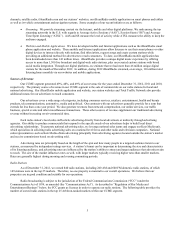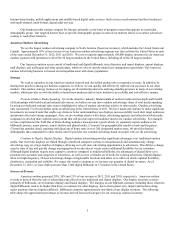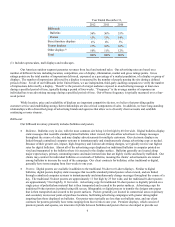iHeartMedia 2012 Annual Report Download - page 13
Download and view the complete annual report
Please find page 13 of the 2012 iHeartMedia annual report below. You can navigate through the pages in the report by either clicking on the pages listed below, or by using the keyword search tool below to find specific information within the annual report.10
Competition
The international outdoor advertising industry is fragmented, consisting of several larger companies involved in outdoor
advertising, such as JCDecaux and CBS, as well as numerous smaller and local companies operating a limited number of displays in a
single market or a few local markets. We also compete with other advertising media in our respective markets, including broadcast
and cable television, radio, print media, direct mail, the Internet and other forms of advertisement. Outdoor companies compete
primarily based on ability to reach consumers, which is driven by location of the display.
Other
Our Other segment includes our 100%-owned media representation firm, Katz Media, as well as other general support
services and initiatives which are ancillary to our other businesses.
Katz Media, a leading media representation firm in the U.S. for radio and television stations, sells national spot advertising
time for clients in the radio and television industries throughout the United States. As of December 31, 2012, Katz Media represents
more than 4,000 radio stations, approximately one-fifth of which are owned by us. Katz Media also represents approximately
500 television and digital multicast stations.
Katz Media generates revenue primarily through contractual commissions realized from the sale of national spot and online
advertising. National spot advertising is commercial airtime sold to advertisers on behalf of radio and television stations. Katz Media
represents its media clients pursuant to media representation contracts, which typically have terms of up to ten years in length.
Employees
As of December 31, 2012, we had approximately 15,000 domestic employees and approximately 5,800 international
employees, of which approximately 13,200 were in direct operations and 7,600 were in administrative or corporate related activities.
Approximately 800 of our employees are subject to collective bargaining agreements in their respective countries. We are a party to
numerous collective bargaining agreements, none of which represent a significant number of employees. We believe that our
relationship with our employees is good.
Seasonality
Required information is located within Item 7 of Part II of this Annual Report on Form 10-K.
Regulation of our Media and Entertainment Business
General
The following is a brief summary of certain statutes, regulations, policies and proposals affecting our media and
entertainment business. For example, radio broadcasting is subject to the jurisdiction of the FCC under the Communications Act. The
Communications Act permits the operation of a radio broadcast station only under a license issued by the FCC upon a finding that
grant of the license would serve the public interest, convenience and necessity. Among other things, the Communications Act
empowers the FCC to: issue, renew, revoke and modify broadcasting licenses; assign frequency bands for broadcasting; determine
stations’ frequencies, locations, power and other technical parameters; impose penalties for violation of its regulations, including
monetary forfeitures and, in extreme cases, license revocation; impose annual regulatory and application processing fees; and adopt
and implement regulations and policies affecting the ownership, program content, employment practices and many other aspects of the
operation of broadcast stations.
This summary does not comprehensively cover all current and proposed statutes, regulations and policies affecting our media
and entertainment business. Reference should be made to the Communications Act and other relevant statutes, regulations, policies
and proceedings for further information concerning the nature and extent of regulation of our media and entertainment business.
Finally, several of the following matters are now, or may become, the subject of court litigation, and we cannot predict the outcome of
any such litigation or its impact on our media and entertainment business.
License Assignments
The Communications Act prohibits the assignment of a license or the transfer of control of an FCC licensee without prior
FCC approval. Applications for license assignments or transfers involving a substantial change in ownership are subject to a 30-day
period for public comment, during which petitions to deny the application may be filed and considered by the FCC.
























